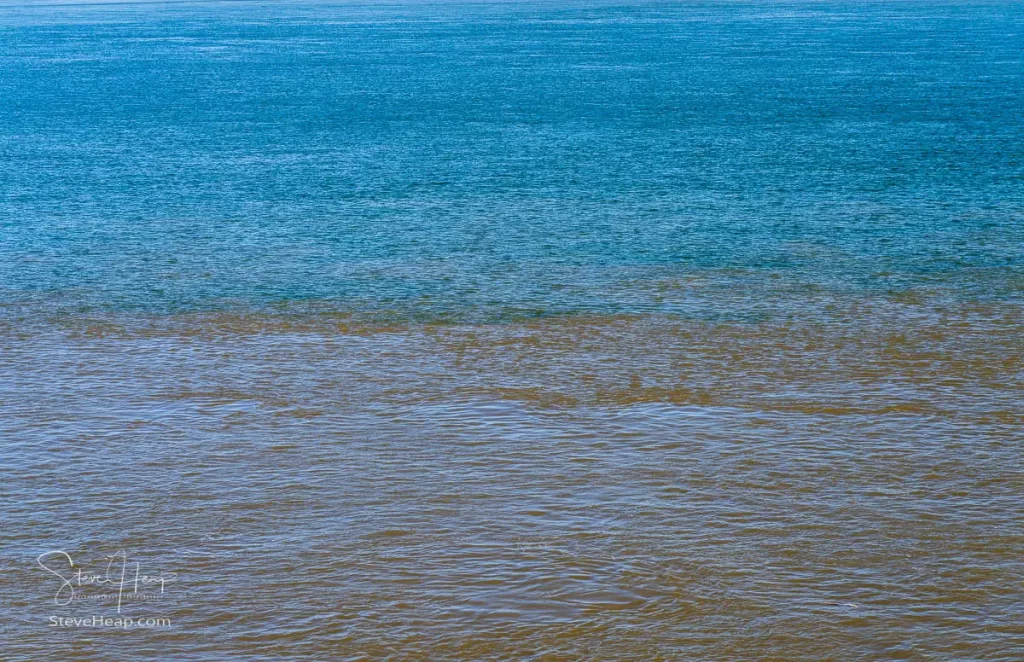Of course, that is a bit of artistic license – ocean cruises often have one day at sea as they sail a longer distance to the next port, and I suspect the Viking Mississippi might tip over if it actually ended up in the ocean. It only has 9 feet of keel under the water!
But, after leaving St Louis, we started our descent of the Lower Mississippi. Strictly speaking, this section starts at Cairo in Illinois, but, as you will see, we arrived there in the late morning. One thing that I didn’t really expect on this cruise was the lack of long-distance views of distant horizon. I guess it is perhaps obvious that with a boat on a river that is at its lowest level in year, what you actually see for much of the journey are the riverbanks. Further north we could definitely see further into the distance, but from here, the raised levees and banks were the limits of vision. The banks themselves could be pretty interesting:

This one looks almost abstract with the deep grooves in the riverbank. I’m not sure how much of this is visible in the summer – not much, I would suspect!
When we awoke, one of the first things I saw was the M/V Potter dredging the channel in the river. At this time of year, this is a constant exercise to keep the river at least 9 feet deep in the navigable channel. This historic dredger (hard to believe it was launched in 1932!) gathers mud from the bottom of the river and pumps it to the edges as you can see.

On our boat, people generally were relaxing after breakfast, taking exercise by walking around the deck or sitting in the Explorer’s lounge just watching the world go by. I did notice, in the far distance, a path of white on the sandy bank which turned out to be a flock of American White Pelicans.

I’ve no idea why they choose to gather in this particular spot – I only saw this twice in the entire trip and on both occasions, the birds were tightly packed just along the edge of the water.

Just before lunch, we arrived at one of the highlights of the day – the confluence of the Mississippi and the Ohio rivers near Cairo in Illinois. The Mississippi starts (with its tributaries such as the Missouri river) in the Rocky Mountains where fast flowing streams and rivers erode the rocks as they tumble down the mountains. They carry that silt as they eventually join the Mississippi and some is slowly deposited on the riverbed but much more is carried in the water all the way to the Gulf of Mexico. The Ohio river mainly gets its water from rain and snow fall and so carries much less silt, especially after a dry spell such as the one we were experiencing. As a result, the difference in the clarity and color of the water is very pronounced as they meet at Cairo.

With a close-up of the “join” the difference in color is very pronounced!

As we travelled further downstream the banks would occasionally open to show some of the industry (farming) in the adjoining states:

And, at New Madrid (the site of a historic earthquake that caused the river to flow up towards the north for a time) the large power station dominates the skyline:

And, of course, throughout the day we had massive flotillas of barges moving in both directions pushed by a “pusher boat”. We had the right of way as we were going with the flow of the river, but sometimes there was not a great deal of room to pass by:

And eventually the day ends with a sunset. Pretty spectacular on this occasion:

But the river barges (and our boat) continues to head downstream towards Memphis Tennessee:

This is one of an extended series of articles about the Viking Mississippi cruise from St Paul in Minnesota to New Orleans in Louisiana. The initial article can be found here. And, the next article about a day in Memphis, Tennessee can be seen here.



